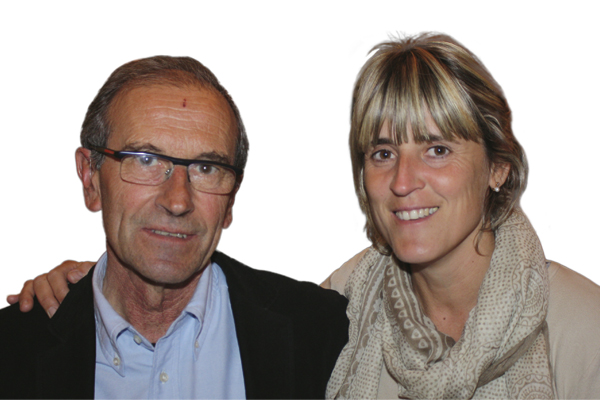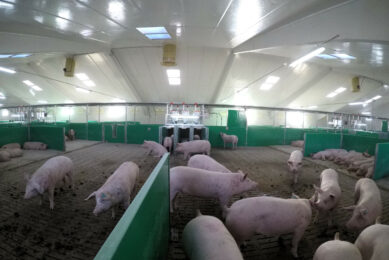Interview: “It all comes down to motivation”

Being involved with roughly 70,000 sows, veterinarians Agustí Camprodon Ylla and Lali Coma Feliu have a message or two to share with the pig world. The key theme in all they say is: If you enjoy what you are doing, the rest will come.
By Vincent ter Beek
The roads leading up to their cooperation have been quite different, so to say.
Agustí Camprodon Ylla only had a vague sense of direction when he started his medical science studies. When finally, he had to make the choice between human and veterinary science, he chose the latter. Then, after having obtained his degree in general veterinary science, common in Spain, he chose to build his experience in England, where he learnt about the principle of artificial insemination in swine. Returning to his native country, he introduced this idea into the Spanish pig industry in the late 1970s. It was then he realised the road ahead for him would be in pigs.
Lali Coma Feliu, on the other hand, knew from a very young age that pigs were going to be part of her career. She literally grew up between the pigs. Her father had a livestock farm – and taught his daughter from the very beginning to be among pigs and how to care for them. His words were not in vain. After having completed veterinary college, all she focused on were pigs. She explains, “My father also has dairy cows, but I never visited any of them when there was a health problem. And even if my own dog is ill, I take it to the see another vet.” But whoever has a question about how to solve an issue in pigs – better ask her.
As do a large number of pig farmers around the city of Vic, located in north eastern Spain, about 50 km north of Barcelona. The majority of pig farmers in this region work independently, and have increasingly turned to Camprodon and Coma for veterinary counsel and support ever since the two decided to join forces as Servicios Veterinarios Camprodon Coma SLP, in 2003. Much the same as feed millers did in the northern Spanish regions of Catalunya and Aragón, as producers typically purchase feed. With support from a laboratory colleague, the two veterinarians are currently indirectly responsible for as many as 70,000 sows.
Success
The key to success in swine production depends on many factors, that much Camprodon and Coma know. But most importantly, without any doubt, is ‘motivation’, they say. Coma says, “The workers must like working with pigs, they should enjoy their job.” Strict, safe and sound – such is Coma’s message.
With motivation and pleasure comes interest and also the will necessary to improve and keep working to become a better and more professional pig farmer or farm employee. Hence Camprodon and Coma encourage their clients to visit shows, to never cease taking classes or additional courses, and to visit other farms from time to time. All will help to increase knowledge and to continue learning.
Camprodon adds, “There are various factors for the success of our clients. First, as discussed, it is motivation, leading to better management. Secondly, we make an analysis of the actual nutrition, genetics and health situation on-farm to being able to establish action points. This is all combined with good farm management in order to eventually improve productivity, sanitary status and animal welfare.”
Crisis
The pig industry is one of the few sectors of the Spanish economy that hasn’t suffered so much from the recent years of crisis and subsequent unemployment on the Iberian Peninsula. On the contrary, explains Coma, “The pig industry remained more or less the same – it even grew slightly.”
Domestic demand remained pretty stable whereas exports grew to about 40% of total production. “Prices for pigs have been quite good,” adds Coma. We have seen prices of €12-15 profit per pig in Spain.” The pigs get sent to the slaughterhouse at approximately 105 kg – castration is not applied.
What the crisis did diminish, however, were the future opportunities for young veterinarians, Coma and Camprodon explain, as there are simply fewer pig farms than ten years ago – and those that remained grew. “At the moment, the average size of our clients’ pig farms is about 400 sows. But there is a large variability. This number includes customers of 100 sows but also of 3,000 sows. The smaller farms, however, are gradually disappearing from the stage – in their place the larger farms are increasing in size. As a result, for new vets it is difficult to find a job.”
One of the main challenges for pig producers in Northern Spain is the fact that expansion is not possible. The pig industry in Catalunya is at its limits and no more sows can be added. The growth can be made by being more proficient and raising more pigs per sow per year and this is where assistance is more than welcome.
Disease pressure makes the region vulnerable with 100,000 sows and 400,000 grow-finishers in a 30 km radius. Coma explains, “Still, the Vic province is free from Aujeszky’s Disease (pseudorabies, ed.), Classical Swine Fever or African Swine Fever. There are farmers with problems like PRRS, M. hyo or S. suis – but we aim to help them with good management advice to deal with this.” They add, “At the moment we are not concerned about a potential outbreak of Porcine Epidemic Diarrhoea (PED) virus. We continue to follow its evolution and we are attentive to the latest updates that appear on the disease.”
“We aim to offer an approach which helps producers step up their health and management. On one hand, we would like to help producers to achieve a way of using fewer antibiotics. This is better for health plus helps producers to bring costs down,” says Coma.
Future
For the future, the two are not worried. Coma says, “The Spanish pig industry has a big potency, as you can tell from export figures. About 40% of the Spanish pig production is made for exports – and this amount is growing. Sure – the industry is facing a lot of challenges now and in the future. Animal welfare is becoming more important, so is further manure treatment and genetics will take a more important position.” As for the new 2013 gestation directive, Coma and Camprodon point to figures indicating that about 90% of gestating sows are in groups these days.
Coma says, “Sometimes, people need to change the chip,” a Spanish expression for making a switch. She continues, “If you want to continue and operate within the law, you need to change your mindset, your way of thinking. Perhaps this is easier for the new generation than for the older. But it is impossible to continue to be in business if you don’t.”
Again, it is all a matter of motivation.
Biographies
Agustí Camprodon Ylla got his veterinary degree from the University of Zaragoza, Spain, in 1979. Between 1979 and 1990 he worked for the company Gepork, responsible for the introduction of artificial insemination in Spain. From 1990 until 2004 he worked as Del año 1990 al 2004 trabaje como veterinary consulutant in various companies in the provinces of Barcelona and Girona in Catalonia, Spain. As of 2004, he joined with Lali Coma Feliu in the company SV Camprodon Coma SLP, which focuses on consulting and pig health for for various farms in Catalonia.
Lali Coma Feliu graduated in veterinary medicine from the University of Barcelona in 1996. Between 1996 and 2002 she worked in Vic province, responsible for the technical pig department at the company Provetsa Vic. During 2002 and 2003 she spent six months in Brazil, where she worked at Consuitex, a consulting company in the pig industyr. As of 2004, she joined Agusti Camprodón Ylla in SV Camprodón Coma SLP.
[Source: Pig Progress magazine Vol 30 nr 5, 2014]











